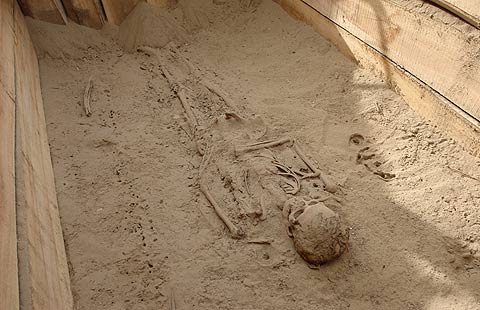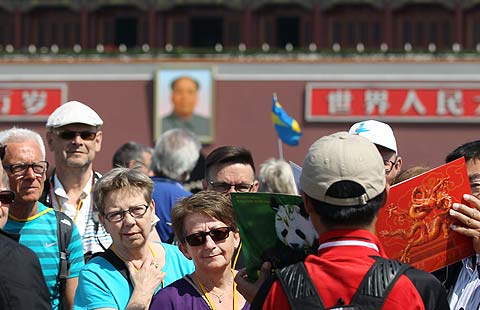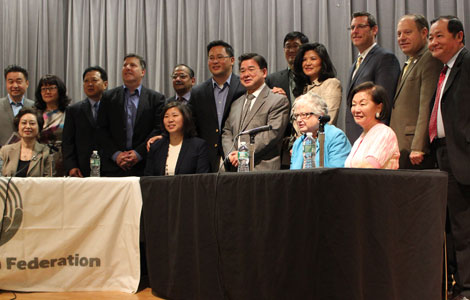Inheritance of joy
Updated: 2014-06-03 07:12
By Wang Kaihao (China Daily)
|
||||||||
The famous carpenters of Xiangshan fight to keep their legacy alive amid challenges. Wang Kaihao reports from Suzhou, Jiangsu province.
A carpenter from Suzhou in eastern Jiangsu province was summoned by Emperor Yongle of the Ming Dynasty (1368-1644) to Beijing almost 600 years ago. Kuai Xiang, who lived from 1398 to 1481, came to the Chinese capital with followers and ended up as one of the chief designers of the Forbidden City.
Many years later when the stunning structure was completed by hundreds of thousands of laborers, the architects led by Kuai came to be known as the "Xiangshan group" , after his sleepy hometown of Xiangshan. Today's Xiangshan still looks tranquil by the Taihu Lake but there are signs of development.
Small holiday resorts line the highway and a wooden bridge across a river is an engineering marvel.
Lu Yaozu, 65, is a fifth-generation architect in his family. His given name means "to bring glory to ancestor". He wants to live up to his proud bloodline as one of the families from the Xiangshan group. Lu started work at 16, when his grandfather passed on his knowledge of carpentry to him, through an oral tradition. He was listed as an inheritor of "intangible cultural heritage" in China.
"We face bodies of water and hills are behind us ... we have good feng shui. That's why local men are born to build houses," Lu jokes. "We don't have farmlands, so that's how we escape hunger."
Lu and Xiangshan's many other carpenters do not possess college degrees but are able to do their jobs as well as professionals if not better.
Traditional Chinese carpentry uses mortise and tenon, delicately designed joints, rather than nails. Xiangshan group's techniques were included in the Chinese traditional architectural craftsmanship for timber-framed structures that were listed an intangible cultural heritage by UNESCO in 2009.
"Traditional architecture in Suzhou has its unique characteristics. Their color, paintings and carving images are natural. We prefer building something that's practical yet delicate rather than just grand. Each design has its function beyond aesthetic purpose," Lu says.
In older times, Xiangshan's artisans followed these characteristics to landscape gardens in Suzhou, also UNESCO World Heritage sites. Lu has renovated several gardens and historical relics in the ancient city but has become more famous for taking Suzhou's gardens overseas.
In 1999, Lu built the Lan Su Chinese Garden in Portland, Oregon. The garden's name - from a combination of Portland and Suzhou - means "awakening orchid" in Chinese. It is the first Chinese garden built abroad by the Xiangshan group and is a major tourist draw in Portland. Lu works on projects throughout the United States, Canada and Europe.
"It is a pity that the US has different concepts for construction. We have to compromise to use some modern skills to follow American safety rules but the adjustment is not perceptible for visitors. Traditional techniques are used for every visible part in the gardens only to keep genuine flavor."
Lu complains that some carpenters from his hometown indulge in "showing off" in foreign lands. "This attitude is unhealthy for our Xiangshan brand."
Xu Jianhua, deputy head of the Xiangshan group association, says that the lack of prominent young inheritors is stalling development of the craft. "It will take at least eight years to nurture a qualified Xiangshan architect. What we can provide now is merely a few months of training," Xu says.
There isn't enough money in the profession and many local people are switching to better jobs. The average monthly salary for today's artisans is often less than 6,000 yuan ($960), which isn't the best pay in Suzhou, one of China's most developed cities. Though migrant workers fill the gap, Xu is concerned about maintaining the traditional standard.
"Even Kuai Xiang's sons abandoned the job after the 23rd generation, and now you can hardly find local artisans below 40," he says, adding that society has failed to respect skilled workers. The absence of a clear national policy on construction and renovation of ancient buildings is an additional challenge.
"Some historians emphasize various styles in different regions and oppose plans to set up a uniform standard. But it is too difficult to maintain quality without a national rule, to regulate the market," Xu says.
Fang Ming, 31, is among young local artisans whose hearts still beat for the craft. Although from a family of the Xiangshan group, he had once moved away from carpentry. He opened a tattoo studio and worked in animation. But he returned in 2003.
Fang says he is optimistic about the future of carpentry because local rich customers prefer traditional gardens in their houses, and they demand conventional skills.
"The Xiangshan group, like the Chinese people, has suffered many strikes. But it will always inherit traditions from former generations."
Contact the writer at wangkaihao@chinadaily.com.cn
(China Daily 06/03/2014 page22)

 Awarding ceremony of 2014 hito Pop Music held in Taipei
Awarding ceremony of 2014 hito Pop Music held in Taipei
 Zhao Liying's photo shoot for Children's Day
Zhao Liying's photo shoot for Children's Day
 'Taken 2' grabs movie box office crown
'Taken 2' grabs movie box office crown
 Rihanna's 'Diamonds' tops UK pop chart
Rihanna's 'Diamonds' tops UK pop chart
 Fans get look at vintage Rolling Stones
Fans get look at vintage Rolling Stones
 Celebrities attend Power of Women event
Celebrities attend Power of Women event
 Ang Lee breaks 'every rule' to make unlikely new Life of Pi film
Ang Lee breaks 'every rule' to make unlikely new Life of Pi film
 Rihanna almost thrown out of nightclub
Rihanna almost thrown out of nightclub
Most Viewed
Editor's Picks

|

|

|

|

|

|
Today's Top News
Abe, Hagel's accusations rejected
Comfort women shrine dedicated
Shandong delegation eyes California trade
Hainan Air receives its 7th Boeing Dreamliner
Accusations from Abe, Hagel rejected
Chinese publishers adapting to American markets
Helping Asian Americans leverage buying power
China Inst. marks 88th with gala
US Weekly

|

|








